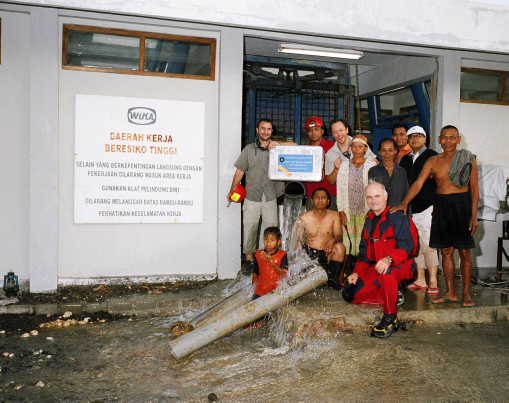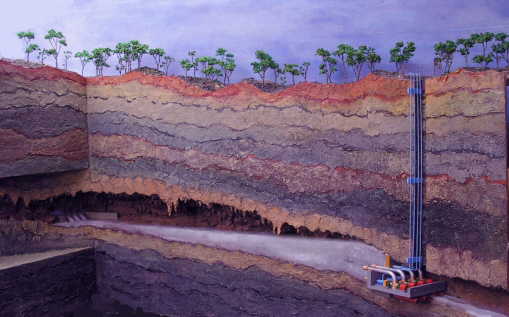Hydraulic engineering experts from the Karlsruhe Institute of Technology (KIT) have built an underground barrage with an integrated water power station in a cave on the Indonesian island of Java. In late July, this plant was tested successfully: The scientists succeeded in damming water in the karst cave. This unique project worldwide is aimed at counteracting water shortage in the south of the island. From the coming year, the cave power station will supply drinking water for 80,000 inhabitants.
The karst region of Gunung Kidul on the southern coast of Java is one of the poorest regions of Indonesia. Soil is too meager for a rich harvest, flowing waters run dry in the dry season. The water arising in the rainy season quickly drains away. “However, it accumulates in an underground cave system”, explains Professor Franz Nestmann, head of the project from the Institute for Water and River Basin Management (IWG) of the Universität Karlsruhe. “This natural water store can be used by our underground power station.” For this purpose, he and his team have developed technologies adapted to nature and the local population – a project of model character, as is underlined by Nestmann: “It may be transferred to karst regions all over the world, for instance, in Laos, Thailand, or Sri Lanka”. Since seven years, the Federal Ministry of Education and Research (BMBF) has been funding the project, within the framework of which German and Indonesian scientists cooperate with industry partners from both countries. The funds provided by the BMBF totalled EUR 3 million.
“Even during the dry season, more than 1000 liters of water per second flow through the Bribin cave – it is an ideal place to build the barrage”, explains Dr. Peter Oberle from the IWG. Water pressure drives turbines that are connected to feed pumps via a gear system. The pumps raise part of the water into a reservoir 200 m above. ”The water storage test in July was a milestone of our project”, underlines Oberle. “Now, we know that the cave really retains the water and that we reach the necessary storage level of 15 m.”
In the coming months, the engineers will install further supply modules and extend the piping. The plant will then start operation in the next dry season from May 2009. Each of the 80,000 inhabitants will be supplied with 70 liters of water per day. “So far, 5 to 10 liters per day have been available to the population in the dry season for personal hygiene, household, and cattle. Every German consumes an average of 120 liters for these purposes”, says Dr. Muhammad Ikhwan from the IWG. A total of 260,000 people are living in the region of Gunung Kidul.
Since 2000, the Karlsruhe scientists have been working regularly in Indonesia. Prior to the start of construction, a detailed feasibility study was made. Within this project, the IWG cooperated closely with other institutes of the Universität Karlsruhe, namely the Institute of Concrete Structures and Construction Materials Technology, the Institute of Soil Mechanics and Rock Mechanics, the Geodetic Institute, and the Institute of Mineralogy and Geochemistry. Geographers from the University of Gießen contributed a socio-economic analysis. Together with several industry partners, adapted technologies have been developed. The Herrenknecht AG (tunnelling systems technology) and the KSB AG (pump technology) funded the project with an amount of EUR 1 million. On the Indonesian side, the government of the province of Yogyakarta and partners from science and industry are involved.
This cooperation will be continued even after the completion of the work in the Bribin cave. A few days ago, the BMBF approved the follow-up project “Integrated Water Resources Management (IWRM)”. Within the framework of this multiyear joint project, the Universität and Forschungszentrum Karlsruhe do not only focus on exploring the underground water resources, but also on distributing the water and improving both water quality and wastewater management.
In addition, the hydraulic engineering experts wish to test another water supply concept. It is suited in particular for caves with a steep incline. In the Seropan cave, the experts will install a pressurized pipeline made of wood that is connected to supply modules. This plant is planned to supply another 80,000 people with water. One of the cooperation partners is the Research Center for Steel, Timber and Masonry Chair of Engineering Timber Structures of the Universität Karlsruhe.
For further information on the joint activities, click the page about cavelab on the internet.

Successful test: Professor Franz Nestmann (front, right) and KIT scientists celebrate the first water supplied by the power station with Indonesian colleagues and the local population.
(Photo by: IWG)
The Karlsruhe Institute of Technology (KIT) is the merger of the Forschungszentrum Karlsruhe, member of the Helmholtz Association, and the Universität Karlsruhe. This merger will give rise to an institution of internationally excellent research and teaching in natural and engineering sciences. In total, the KIT has 8000 employees and an annual budget of 700 million Euros. The KIT focuses on the knowledge triangle of research – teaching – innovation.
The Karlsruhe institution is a leading European energy research center and plays a visible role in nanosciences worldwide. KIT sets new standards in teaching and promotion of young scientists and attracts top scientists from all over the world. Moreover, KIT is a leading cooperation partner of industry.

